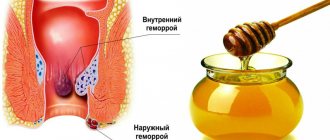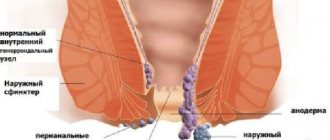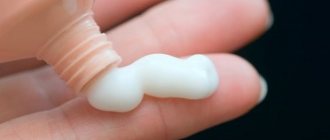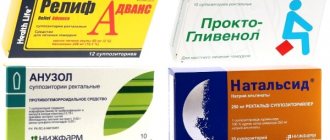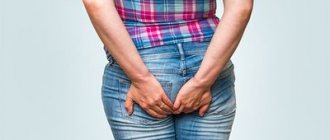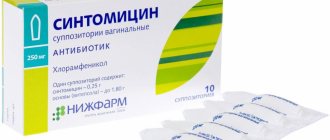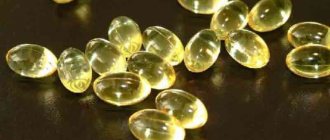Modern medicine offers many effective methods of therapy, each of which has its own advantages and contraindications. Many patients try to alleviate symptoms and relieve pain with the help of medications. The most popular are rectal suppositories. They act directly on the lesion and do not require special preparation. We will consider below which suppositories are best to choose for the treatment of hemorrhoidal “bumps”.
The most effective suppositories for hemorrhoids according to buyers
This section includes suppositories that received the largest number of positive reviews from patients with the initial stages of the disease.
- Methyluracil is an effective drug with a pronounced immunostimulating and anti-inflammatory effect. The use of this drug allows achieving remission in 95% of patients. It accelerates the healing of damage to the mucous membrane and stimulates epithelial renewal. Another advantage of the drug is its price - less than 100 rubles.
- Nigepan. These suppositories have analgesic, anti-inflammatory and thrombolytic effects. Its cost ranges from 400 to 500 rubles.
- Proctosan is a medicinal product with a natural composition. These suppositories relieve inflammation, pain, itching, and also reduce bleeding from hemorrhoids and promote their rapid healing.
What are they?
Classification of candles:
| Painkillers: | based on components with a pronounced analgesic and calming effect. Includes anesthesin, benzocaine, lidocaine, belladonna extract, propolis and other active substances. These remedies are used to relieve pain in the anus. |
| Hemostatic: | designed to relieve bleeding, a common symptom of hemorrhoids. There are candles that contain adrenaline or ice. |
| Disinfectants: | used in case of infection of wounds due to hemorrhoids. These medications include antibiotics that eliminate most pathogens. |
| Anti-inflammatory: | They relieve the inflammatory process of the disease well and have a partial analgesic effect. |
| Venotonic: | restore blood vessels and capillaries, strengthen their walls, and prevent fragility. Thanks to this, hemorrhoids decrease in size, reducing the likelihood of developing new lumps. |
| Healing: | used for the appearance of anal fissures, they have a regenerating, restorative effect. |
| Combined: | have several effects at once, combining antiseptic, anti-inflammatory, analgesic effects. |
For each patient, suppositories are selected depending on which symptom of the disease predominates. This may be itching, bleeding, swelling, pain, inflammation and other manifestations.
Rectal suppositories for severe pain syndrome
Here we will talk about a list of the most effective pain-relieving suppositories used to treat hemorrhoids.
- Proctosedyl M. The composition contains antibacterial, hormonal and analgesic substances. Due to the large number of strong active ingredients, the drug quickly relieves all manifestations of hemorrhoids, even severe ones.
- Procto-glivenol. The drug relieves intense pain and relieves patients from itching. Also, due to the presence of tribenoside in the composition, it improves blood flow in the inflamed area and eliminates swelling.
- Relief Advance - soft suppositories for hemorrhoids. Due to the content of a large amount of vegetable oils, the drug gently relieves pain and reduces inflammatory reactions.
- Relief Ultra. Unlike the previous drug, it also contains a hormonal component, thanks to which it fights the manifestations of hemorrhoids even more actively. At the same time, its cost is, of course, higher.
- Hematrombin G. The drug has a lightning-fast effect. Literally a minute after administration, it relieves itching and pain in the affected area. The effect is realized due to the content of the hormone prednisolone in the suppositories. However, these suppositories do not treat the disease, but only relieve symptoms, and therefore have a short-term effect.
Other means
Microlax, which is available in a solution for rectal administration using microenemas, will help cure hemorrhoids that are bleeding.
This drug is a combination drug that has a laxative effect. The components included in the medicine help soften stool during constipation, which often causes bleeding.
In addition, Microlax affects the receptors of the intestinal mucosa, as a result of which peristalsis is stimulated. Thanks to this action, bowel movements are improved.
Thus, there is a large selection of pharmaceutical agents for the treatment of internal or external bleeding due to hemorrhoids. They are available in the form of tablets, injection solutions, microenemas, ointments, creams and rectal suppositories.
However, it is important to remember that some of them have adverse reactions or may be contraindicated in various conditions. Therefore, it is necessary that such drugs be prescribed by a qualified specialist.
Inexpensive suppositories for hemorrhoids
Most medications for hemorrhoids are quite expensive. Is it possible to find cheap and effective drugs? Of course. This section will present the most popular candles with a loyal pricing policy.
- Belladonna extract is the most natural preparation. Contains exclusively herbal ingredients and costs around 50 rubles. These suppositories relieve spasms and significantly relieve pain. However, the drug will not be able to cope with severe manifestations of the disease, so it is recommended only for mild cases.
- Betiol, like the previous type of suppositories, has a moderate analgesic and antispasmodic effect. The price does not exceed 100 rubles.
- Ichthyol. The drug effectively eliminates pain and also has an antiseptic effect.
Natalsid
A natural medicine whose effect is due to a natural ingredient – sodium alginate. This substance stops bleeding, heals wounds, relieves pain, and relieves inflammation. In addition, intestinal function is further normalized.
Contraindications include the following conditions:
- intolerance to components;
- age restrictions (prohibited under 14 years old).
When diagnosed with internal hemorrhoids, treatment is carried out for 1-2 weeks, the frequency of use is 1 suppository 2 times a day. Customer reviews confirm that suppositories are well tolerated, only in some situations allergic reactions may occur.
How to insert correctly
Before using rectal suppositories, you must take a hygienic shower, paying special attention to cleansing the perianal area.
It is recommended to insert suppositories once a day after defecation in the morning or evening. If constipation occurs, it is recommended to take a mild, herbal laxative.
Attention! Most suppositories for hemorrhoids have side effects and contraindications, so their use requires mandatory consultation with a specialist. The doctor will select the most suitable drug for you, which will help you quickly cope with the disease.
Contraindications and negative reactions
A contraindication to the use of relief candles is individual intolerance to any components in their composition. Due to the fact that the products contain different substances, it is necessary to read the instructions for use before carrying out treatment.
Relief suppositories are contraindicated for thromboembolism and granulocytopenia. Treatment with elevated sugar levels should be carried out with extreme caution. Conditional contraindications include hypertension, hyperthyroidism, pathologies of the cardiovascular system, and hepatitis. It is not advisable to use relief suppositories during pregnancy and lactation. Suppositories are prescribed only after reaching the age of 12 years.
If contraindications are excluded and the doctor’s recommendations are followed, negative reactions of the body are rarely observed. Sometimes allergic reactions, increased blood pressure and increased heart rate occur. In such cases, you should stop using suppositories and consult a doctor.
Do not use relief candles if the packaging is damaged. This poses a risk of infection. Also, you should not use expired product.
Conservative treatment of hemorrhoids: experience with the use of Relief drugs
Hemorrhoids are a disease of external and internal hemorrhoids. Combined hemorrhoids are prolapse of internal hemorrhoids and external hemorrhoids at the same time. In chronic hemorrhoids, the main symptoms are bleeding and prolapse of hemorrhoids from the anal canal [1]. Hemorrhoids, like many diseases, have a wave-like character: a chronic course is replaced by exacerbation. Acute hemorrhoids are, first of all, thrombosis of hemorrhoids or bleeding hemorrhoids, complicated by anemia. Thrombosis of nodes can quickly, within 24 hours, be accompanied by an inflammatory process. Acute hemorrhoids are divided into three degrees: 1) thrombosis of hemorrhoids without inflammation; 2) thrombosis with inflammation in the node itself; 3) spread of the inflammatory process to the surrounding tissue. Often bleeding hemorrhoids are complicated by chronic anemia, less often - in 4-5% of cases - by acute anemia. The chronic course of hemorrhoids is divided into 4 stages. Stage I is characterized only by the discharge of scarlet blood from the anal canal during defecation without prolapse of the nodes. Stage II is characterized by prolapse of hemorrhoids with their independent reduction into the anal canal (with or without bleeding). At stage III, periodic loss of nodes requires their manual reduction into the anal canal (with or without bleeding). Stage IV is characterized by constant prolapse of hemorrhoids, sometimes together with the mucous membrane of the anal canal (with or without bleeding). Indications for drug treatment: 1) acute hemorrhoids; 2) chronic hemorrhoids of early stages; 3) perioperative period; 4) prevention of hemorrhoids [2]. Drug treatment of acute and chronic hemorrhoids consists of general and local use of analgesics, phlebotonics, anti-inflammatory, hemostatic and local combination drugs [3].
The place of conservative therapy in the treatment of hemorrhoids
Conservative treatment of hemorrhoids is based on a combination of systemic and topical medications. The leading place in systemic therapy is occupied by phlebotonic drugs, especially micronized diosmin with a hesperidin fraction. To eliminate thrombosis of hemorrhoids, pentoxifylline, acetylsalicylic acid and, of course, combined phlebotonic drugs are also taken in the form of systemic drugs. Drugs from the benzopyrone group also improve blood flow in hemorrhoids. The use of local drugs helps reduce pain and inflammatory syndromes, enhances the effect of systemic painkillers and phlebotonics, which reduces rehabilitation time. In the acute period, a 7–10-day course of treatment with local drugs is sufficient, and in the chronic course, as a preventive measure, the course can be continued for up to 1.5–2 months. Pathogenetically based pharmacotherapy solves a number of problems: 1) elimination of inflammation; 2) pain relief; 3) elimination of thrombosis of hemorrhoids; 4) stopping bleeding. To eliminate inflammation, non-steroidal anti-inflammatory drugs (NSAIDs), systemic enzyme therapy, various ointment forms containing NSAIDs, as well as phlebotonics are used. The anti-inflammatory effect of NSAIDs is ensured by inhibition of the biosynthesis of prostaglandins, which are important in the pathogenesis of inflammation and pain [4]. In acute thrombosis of hemorrhoids, topical combination drugs are more often used to relieve inflammation, such as tribenosine with lidocaine, a combination drug containing bufexamak, bismuth subgallate, titanium dioxide, lidocaine hydrochloride. These drugs have a venotonic and anti-inflammatory effect. They improve vascular tone, reduce venous congestion in the cavernous bodies, and improve microcirculation. Their anti-inflammatory effect is explained by the inhibition of endogenous substances that play the role of mediators in the development of inflammation. Lidocaine hydrochloride in the gel substrate has a rapid and long-lasting analgesic effect. To relieve pain in acute hemorrhoids, non-narcotic analgesics (antipyretics based on metamizole), paracetamol derivatives, as well as NSAIDs in the form of systemic and local therapy are usually used. The combination of topical drugs and NSAIDs has a pronounced anti-inflammatory and analgesic effect. For pain associated with acute anal fissure, complicating the course of hemorrhoids, antispasmodic drugs are effective, as well as derivatives of nitroglycerin and nifedipine on a special ointment base for topical use, which have an antispasmodic effect on the internal sphincter. To treat thrombosis in hemorrhoids, heparin-containing ointments and gels are used. The use of heparin-containing drugs promotes the regression of thrombosed hemorrhoids, reducing swelling and hyperemia of the skin, and the inflammatory reaction. Combination preparations containing sodium heparin, polidocanol, dexpanthenol and hydrocortisone are more effective. Heparin binds plasma coagulation and inhibits hemostasis, polidocanol provides an analgesic effect, dexpanthenol stimulates repair processes, and hydrocortisone has an anti-inflammatory effect. With acute bleeding hemorrhoids, chronic or acute anemia may develop, the severity of which depends on the activity of bleeding, its frequency, and the amount of blood loss. For systemic therapy for bleeding from hemorrhoids, a fairly effective drug, tranexamic acid, an activator of thromboplastin formation, sodium ethamsylate, and a heparin antidote, protamine sulfate, are used. The variety of forms and stages of hemorrhoids during its drug treatment requires an individual approach. For hemorrhoidal bleeding, local medications are mainly used. Of these, the α-adrenomimetic phenylephrine is quite effective, as well as sodium alginate, which reduces the polymerization time of fibrin monomer at the final stage of blood coagulation. In case of severe bleeding, collagen hemostatic sponges consisting of fibrinogen and thrombin are used for local treatment. After insertion into the anal canal, the hemostatic sponge dissolves and forms a fibrin film that blocks the bleeding areas of the hemorrhoids. To date, a local remedy, Relief, has been proposed for the treatment of various forms of hemorrhoids, represented by five drugs with different mechanisms of action [5]. They have analgesic, hemostatic, and pronounced anti-inflammatory properties, which are characteristic of certain forms of the Relief line of drugs. The different composition and, accordingly, the different predominant effect of each drug make it possible to take into account the clinical form, stage, and certain symptoms of hemorrhoids, which provides an individual approach to therapy. The drug Relief eliminates bleeding due to phenylephrine, which has a vasoconstrictor, decongestant, and antipruritic effect; The speed of the effect is ensured by the cocoa butter included in the base, which easily melts when the suppository is introduced. Relief suppositories are prescribed for the treatment of internal hemorrhoids with a predominance of edema and bleeding. Relief ointment contains natural corn and thyme oils in its base and is used to treat primarily external hemorrhoids. Relief Advance is a drug containing benzocaine that has a local effect, with minimal risk of side effects, and is indicated for the treatment of hemorrhoids with severe pain, as well as for use after proctological operations. Suppositories are used primarily for the treatment of internal hemorrhoids, ointment - for the treatment of external hemorrhoids. Relief Advance contains benzocaine, a local anesthetic that is safe because, due to its chemical structure, it has virtually no systemic effects. Relief Ultra is a drug with an anti-inflammatory effect, with a minimal risk of side effects, indicated for the treatment of exacerbations of hemorrhoids and other diseases of the anorectal area (fissures, erosion of the anus, proctitis, anal itching, eczema, dermatitis of the perianal area). A distinctive feature of the drug Relief Ultra is the presence of hydrocortisone in its composition, 10 mg in one suppository. Hydrocortisone acetate, which is part of Relief Ultra, has anti-inflammatory, desensitizing, antiallergic, vasoconstrictor and antipruritic effects. In the local treatment of acute hemorrhoids, hydrocortisone inhibits the release of important inflammatory mediators. The second component of the unique combination of Relief Ultra suppositories is zinc sulfate, which promotes the healing of wounds and erosions. Taken together, this provides a combined local effect of the Relief Ultra drug, and the base of the suppositories - cocoa butter - promotes rapid melting of the suppositories in the anal canal, which is especially important during the inflammatory process. In a randomized study in 60 patients with pathology of the anorectal region, the effectiveness of Relief ointment was studied [6]. The patients were divided into 2 equal groups (n=30), main and control. Each of them included 15 patients suffering from mixed hemorrhoids, and 15 patients after surgical interventions. After treatment with Relief ointment in the main group, 14 out of 15 patients with hemorrhoids (93%) noted a marked improvement in their general condition due to a decrease in pain and itching. All 15 patients in this group who underwent hemorrhoidectomy showed a significant reduction in swelling, itching and hyperemia, rapid cleansing of the wound from purulent-fibrinous contents, and easier defecation. Primary granulation and epithelialization appeared in the study group, on average, 2–3 days earlier than in the control group. The drug did not cause any allergic or toxic reactions and can be recommended for the treatment of hemorrhoids. The effectiveness of Relief Advance hemorrhoidal suppositories in patients with chronic hemorrhoids on an outpatient basis was demonstrated in a study by V.V. Darwin et al. [7]. The results of conservative treatment of 30 patients with chronic hemorrhoids who were undergoing outpatient treatment showed the effectiveness of Relief Advance suppositories. An excellent result on the 7th day was obtained in 46.7% of patients, on the 14th day – in 70%, on the 21st day – in 82.8%. The drug is especially effective in patients with stages I–II of the disease. A lesser effect of Relief Advance suppositories was noted when used in patients with stage III chronic hemorrhoids. In this case, Relief Advance can be a means of preparation for surgery, and also be included in the postoperative treatment program [7]. A.V. Sparrow et al. [8] studied the clinical effect of using rectal suppositories Relief, Relief Advance, Relief Ultra, and Relief Advance ointment in 32 proctological patients with various diseases of the anorectal area, as well as in the postoperative period. The control group consisted of 11 people who were not prescribed Relief group drugs. It was noted that the combination of Relief Advance suppositories and Relief Advance ointment turned out to be the most effective. The next in terms of analgesic effect were Relief Ultra suppositories, and Relief suppositories showed somewhat worse, although quite good results (Fig. 1).
Along with a decrease in pain, patients in the main group showed a more rapid decrease in swelling in the operation area, a decrease in the frequency of postoperative bleeding and accelerated wound healing. All operated patients were discharged at the end of the study after an average of 9±2 days. It is worth noting the good therapeutic effect as part of complex therapy of Relief Ultra suppositories containing hydrocortisone, and for such difficult-to-treat pathology as anal itching [8]. A study of the clinical effect of suppositories and Relief ointment in the treatment of inflammatory-vascular processes accompanied by pain and itching, in the treatment of cryptitis, papillitis, anal fissures, acute and chronic forms of hemorrhoids was presented in a study by T.V. Abuladze, which included 30 patients [9]. When using both forms of the drug, the analgesic effect occurred quickly and lasted up to 2–4 hours. The pain syndrome was relieved in 23 cases (77%), of which in patients with acute hemorrhoidal thrombosis - in 5 out of 5 (100%), chronic hemorrhoids - in 12 out of 14 (85.7%), with anal fissures - in 5 out of 5 (100% of cases). With repeated 6-day use, the effect was positive in all cases. The swelling subsided, the hemorrhoids decreased in size, and the pain was relieved. Thus, the treatment of both chronic and acute processes in the anal canal with Relief drugs gave a positive result. In an open study conducted at the coloproctology center of St. Petersburg, Relief Ultra suppositories were used in 35 patients with stage I–II hemorrhoids and in 23 patients with acute thrombosis of hemorrhoids. Relief Advance ointment was prescribed to 41 patients after various proctological operations. The control group included 70 patients who received traditional treatment (heparin ointment, syntomycin, levomekol). An excellent treatment result was achieved in 80% of patients - there was no pain and dysuric disorders, and the phenomena of hemorrhoidal vein thrombosis and inflammation quickly stopped. 17% of patients had a good treatment result, which consisted of an effective effect of the drug on the processes of healing and inflammation, while maintaining pain, for the relief of which analgesics were used. In 3% of patients, the drug was discontinued due to the development of intolerance (itching, hyperthermia) [10]. It is important to know that the majority of patients with hemorrhoids have irritable bowel syndrome, most often in the form of constipation, so such patients are required to undergo targeted treatment. It consists in the use of hydrophilic colloids, enzyme preparations, eubiotics and prokinetics. Treatment of irritable bowel syndrome is a prerequisite for the effectiveness of prevention and successful treatment of any form of hemorrhoids. After removing the inflammatory process, it is necessary to carry out treatment that improves the reparative properties of tissues. Deproteinized hemoderivative of calf blood, containing derivatives of nucleic acids and low-molecular peptides, improves the course of energy-dependent metabolic processes in the body. The drug improves the body's supply of oxygen and glucose, stimulates the activity of oxidative phosphorylation enzymes and improves microcirculation in tissues. An ointment containing microbial cells of Escherichia coli killed by phenol also has a local reparative effect. Its action is based on increasing local tissue resistance to the effects of pathogenic microflora. This process occurs with the help of cell wall antigens and metabolic products of Escherichia coli upon contact with the rectal mucosa and perianal skin. The drug stimulates the T-lymphocyte system of intestinal immunity, increases the phagocytic activity of leukocytes and cells of the reticuloendothelial system, normalizes the tone of blood vessels and stimulates the regeneration of damaged tissues. Pharmacoprophylaxis of hemorrhoids is necessary in risk groups: patients with constipation, leading a sedentary lifestyle, as well as pregnant women. In some cases, including during pregnancy, it is necessary to prescribe phlebotropic drugs. The question of their use during pregnancy and the postpartum period is decided individually. In addition, during pregnancy and the postpartum period, Relief can be used topically in case of bleeding from the anus or itching. For hemorrhoids with severe pain, it is advisable to prescribe Relief Advance in the form of suppositories or ointments. These drugs are approved for use in women of any stage of pregnancy. In a study by N.V. Knyazeva and S.N. Pernakova [11] on 110 patients showed that the drug Relief is an effective treatment for hemorrhoids and other diseases of the anorectal area in postpartum women in the late postpartum period. A positive result with the use of the drug Relief was achieved in 87.5% of patients: tissue swelling, itching in the perineum, discomfort, and bleeding disappeared. Elimination of itching and discomfort was observed within 5 minutes from the moment of introduction of the Relief suppository into the rectum. The authors conclude that the study drug in a dose of 1 suppository 2–4 times a day for 7–10 days is well tolerated by patients and rarely causes side effects.
Contraindications
First of all, systemic and local drugs intended for the treatment of hemorrhoids are contraindicated if there is a history of allergic reactions and intolerance to these drugs or their components. A relative contraindication to the use of heparin-containing agents is blood clotting disorders. In the first trimester of pregnancy, NSAIDs and glucocorticoids, both in systemic therapy and for local use, as well as systemic drugs for the treatment of hemorrhoids, are generally contraindicated. In the II–III trimester, postpartum period, and during breastfeeding, limited systemic and local use of drugs is possible, taking into account the risk-benefit ratio. Combined pharmacotherapy for acute or chronic hemorrhoids is accompanied by a long-term positive effect, but the resumption of constipation and a violation of the diet can again cause an exacerbation. Therefore, it is necessary to carry out the prevention of hemorrhoids in the form of 1.5–2 month courses 2 times a year, using small doses of combined phlebotonic drugs. Thus, the choice of method of conservative treatment of hemorrhoids depends on the severity of symptoms, and the simultaneous use of systemic and local treatment can quite effectively stop acute processes, reduce the number of exacerbations and prevent their development.
Reviews
Lena: I think that medicine does not have to be expensive to cope with the problem. What matters is whether it suits you or not. For hemorrhoids, I took almost the cheapest Anuzol suppositories. They help me well, especially to relieve discomfort after going to the toilet. I can recommend trying it if you also have pain due to hemorrhoids.
Stanislav: Anestezol suppositories have become my salvation. Hemorrhoids are already chronic; when they worsen, the pain is unbearable, and besides, sometimes an anal fissure opens. During such periods, candles go away just like water - you can’t buy enough, so Anestezol is the best help you can get for little money. Relieves pain almost immediately after administration and retains the effect for a long time.
Katya: I may not have such a serious problem as others have. It’s just that at one point after a hiking trip, I realized that there was no bowel movement for almost 5 days. While I was trying to “correct the situation,” I felt that an unpleasant tension arose in the rectum and as if a foreign body had appeared. That’s why it started to ache and itching appeared. Mom advised me to put a candle with sea buckthorn oil to soften everything there. I put 1 piece a week. for the night. In addition to the fact that the stool improved, these unpleasant sensations also disappeared. In my opinion, suppositories with sea buckthorn are a good remedy if you need to relieve inflammation from hemorrhoids, especially if the case is not advanced.
